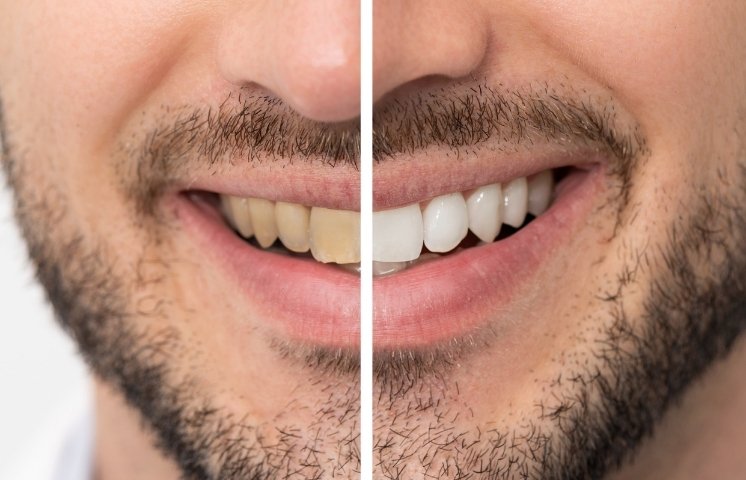New Patients Welcome!

Whitening strips have gained popularity as a convenient at-home solution for brightening teeth and improving smiles. These strips are coated with a peroxide-based gel that bleaches the enamel, effectively removing stains and discoloration. While they offer a straightforward method to enhance dental aesthetics, questions often arise regarding the best practices for oral care immediately after their use. One common query is whether it’s advisable to brush your teeth right after using whitening strips. In this comprehensive blog post, we will delve into the mechanisms of whitening strips, the potential effects on dental health, and expert recommendations for post-whitening dental care.
Understanding How Whitening Strips Work
Before addressing the brushing dilemma, it’s crucial to understand the process of whitening strips and their impact on oral health:
1. How Whitening Strips Work: Whitening strips are thin, flexible plastic strips coated with a hydrogen peroxide or carbamide peroxide gel. When applied to the teeth, these chemicals penetrate the enamel and oxidize stains, effectively lightening the color of the teeth. The length of treatment and concentration of the bleaching agent vary depending on the brand and formulation of the strips.
2. Effects on Dental Health: While whitening strips are generally safe and effective when used as directed, they can lead to temporary side effects such as tooth sensitivity and gum irritation. These effects are often related to the bleaching agent’s penetration into the tooth structure and its interaction with the nerves in the pulp.
Should You Brush Your Teeth Immediately After Using Whitening Strips?
The decision to brush your teeth immediately after using whitening strips depends on several factors, including enamel vulnerability and sensitivity:
1. Enamel Vulnerability: After using whitening strips, the enamel becomes temporarily more porous due to the chemical action of the bleaching agent. Brushing immediately afterward may potentially exacerbate this vulnerability, leading to increased sensitivity or enamel erosion, especially if abrasive toothpaste is used.
2. Immediate Post-Whitening Care: Dentists often recommend waiting at least 30 minutes after removing whitening strips before brushing. This waiting period allows the enamel to remineralize and regain its strength, reducing the risk of damage from brushing.
3. Gentle Post-Whitening Practices: Instead of brushing immediately, consider the following gentle practices to maintain oral hygiene after using whitening strips:
- Rinse Thoroughly: After removing the strips, rinse your mouth thoroughly with water to remove any residual bleaching agent.
- Use a Soft Toothbrush: When you brush, opt for a soft-bristled toothbrush to minimize enamel wear and avoid exacerbating sensitivity.
- Non-Abrasive Toothpaste: Choose a toothpaste that is formulated for sensitive teeth or one that is non-abrasive to minimize the risk of enamel damage.
General Oral Care Tips After Using Whitening Strips
To maximize the benefits of whitening strips and maintain overall oral health, consider these additional tips:
1. Limit Staining Foods and Beverages: Immediately after using whitening strips and throughout the treatment period, avoid consuming foods and beverages that can stain teeth, such as coffee, tea, red wine, and dark berries. These substances can counteract the whitening effects and compromise your results.
2. Manage Tooth Sensitivity: If you experience heightened tooth sensitivity during or after using whitening strips, consider these strategies:
- Desensitizing Toothpaste: Use a toothpaste specifically designed for sensitive teeth to help alleviate discomfort and protect nerve endings.
- Adjust Treatment Frequency: If sensitivity persists, reduce the frequency of whitening strip use or shorten the duration of each treatment session as recommended by your dentist.
3. Regular Dental Check-ups: Schedule routine dental check-ups to monitor the health of your teeth and gums. Your dentist can assess the effectiveness of your teeth whitening treatment, address any concerns related to sensitivity or oral health, and provide personalized recommendations for ongoing care.
4. Maintain Good Oral Hygiene: Continue to practice good oral hygiene habits by brushing your teeth at least twice daily and flossing regularly. These practices help remove plaque buildup, prevent cavities, and maintain the overall cleanliness of your mouth.
Potential Risks of Improper Post-Whitening Care
Failure to follow proper post-whitening care practices can lead to potential risks and complications:
- Increased Tooth Sensitivity: Brushing too soon after using whitening strips can exacerbate tooth sensitivity, making it uncomfortable to consume hot or cold foods and beverages.
- Enamel Erosion: Abrasive brushing immediately after using whitening strips may contribute to enamel erosion over time, compromising tooth structure and potentially leading to dental issues.
- Gum Irritation: Vigorous brushing or using abrasive toothpaste can irritate the gums, causing inflammation or recession and detracting from your overall oral health.
Whitening strips offer a convenient and effective method for achieving a brighter smile at home. However, proper post-whitening care is essential to minimize potential side effects and maintain optimal oral health. While immediate brushing after using whitening strips is generally discouraged, adopting gentle oral hygiene practices such as rinsing with water and using a soft-bristled toothbrush can help maintain cleanliness without compromising enamel integrity. For personalized guidance on whitening strip use and oral care routines tailored to your dental needs, consult with your dentist. By combining effective whitening techniques with gentle post-care strategies, you can achieve a radiant smile while safeguarding your oral health for the long term.




